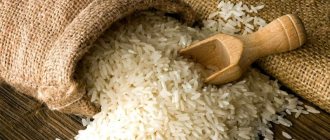How long can coffee beans be stored at home?
Raw coffee beans last much longer.
As for coffee beans, be it Arabica, Robusta or other varieties, the shelf life is primarily affected by the degree of roasting. Raw grains retain their taste and aromatic qualities for quite a long time. Typically, the manufacturer designates a period of time as one year long, however, properly processed grains can be stored for about 3 years. Some varieties, subject to the necessary storage conditions, will remain suitable for up to 5 years, and this is the maximum period. True coffee connoisseurs will not allow themselves to purchase a product that is more than a year old.
It is worth remembering that the date on the packaging is not the date when the coffee beans were collected, but the date when they were packaged at the factory. Therefore, to be sure of the freshness of the beans, you can safely count the year from the date that is at least 1.5 - 2 months earlier than the date stamped on the packaging.
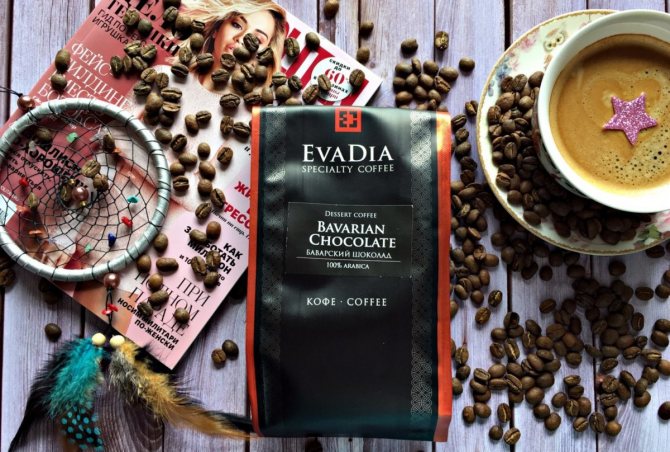
After heat treatment, the shelf life and quality are sharply reduced
After roasting, the shelf life of coffee at home is sharply reduced. This occurs due to the effect of temperature on the properties of grains. Heat treatment reveals a bouquet of essential oils, which give the drink a unique aroma with a slight bitterness. They evaporate quickly, so packaging is essential to preserve them.
- In an unsealed container, such as a jar or box, after opening, the grains will remain fresh for only 10-15 days, but, as a rule, this period is even shorter due to air humidity that is unsuitable for the grains.
- Foil will preserve the taste and aroma of a strong drink for up to a month.
- A special multi-layer sealed bag will ensure the preservation of coffee for up to 6 months, and when using an additional inner layer, where the base is polymer - up to 9 months.
- Packaging that requires thermal sealing and is equipped with a special valve to remove carbon dioxide will preserve the contents for a year.
- The best option for storing roasted beans is considered to be an opaque glass, ceramic or metal jar with an airtight lid, for example, like those of the Black Card, Illy brands; such packaging will allow you to enjoy fresh coffee even 18 months after packaging in production.
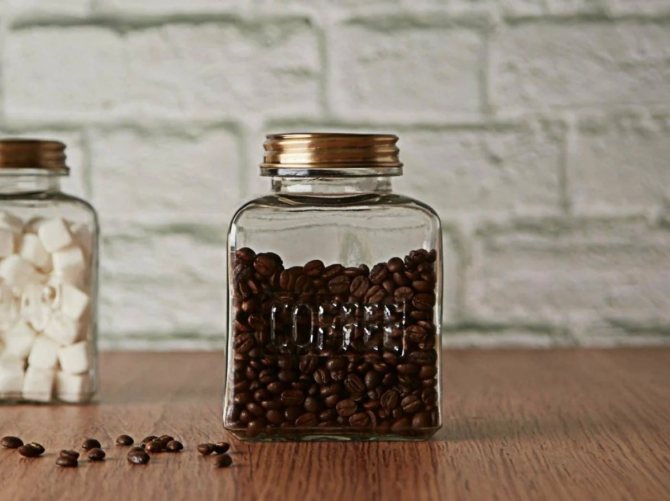
Ground coffee is even more capricious: if you grind it at home, its shelf life is no more than 3 months. But over time, the taste and aroma of the drink will remain only a memory. Volatile compounds break down even more quickly than in whole roasted beans. And they are replaced by smells floating in the air. To maximize the freshness of ground coffee, you should immediately wrap it in foil, for example, like the packaging of the Lebo or Jardine brands, and put it in a dark, dry place. Another way is to place the powder in a ceramic bowl, cover tightly with a lid and put it in the refrigerator.
But leaving freshly ground coffee directly in the coffee grinder is not the best idea; in this form it will retain its properties for no more than 2 weeks. Experienced coffee lovers recommend grinding the beans in small quantities immediately before brewing, so that the taste and aroma of the drink will be most vivid.
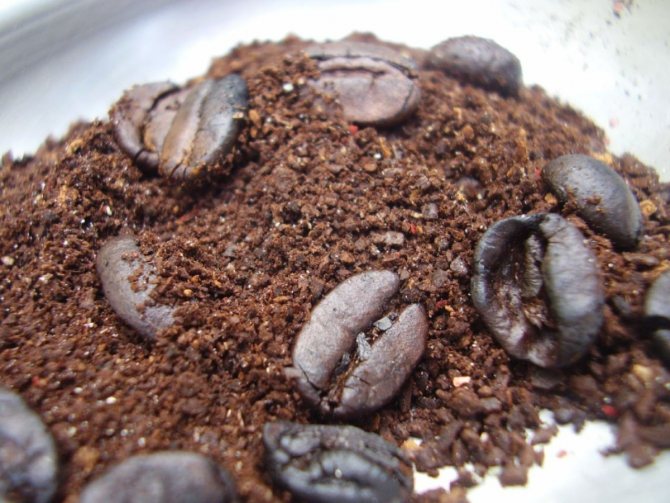
It is best to store ground coffee in a foil package or in a tightly closed and opaque glass container.
As for factory grinding, it is done immediately before packaging and minimizes the loss of taste and aromatic qualities. The shelf life will again depend on the type of expiration date and place of packaging:
- Paper and polyethylene will preserve the product for 6-9 months.
- A bag with a foil layer will extend this period to 18 months.
But if the original packaging is violated, ground coffee will lose its properties within 2 weeks.
Duration of storage of ground grains
Most lovers of the aromatic invigorating drink prefer to purchase it in whole grains. This is due to the fact that it is very difficult to store it in crushed form; it quickly loses its properties. If you purchased ground coffee in vacuum packaging, then after opening it can be stored for no more than two weeks. The essential oils contained in it evaporate very quickly. The shelf life of ground coffee, if it was ground yourself, does not exceed three days.
You will be interested in: Is it possible to drink coffee on an empty stomach - the consequences
Coffee lovers advise:
- Purchase exclusively whole grains and grind them in a coffee grinder immediately before preparing the drink.
- If you still decide to buy ground coffee, then you should not buy it for future use; it is better to opt for a small amount.
- It is best to store it in a tightly sealed container, as far as possible from any strong-smelling products.
- Avoid exposure to moisture and direct sunlight.
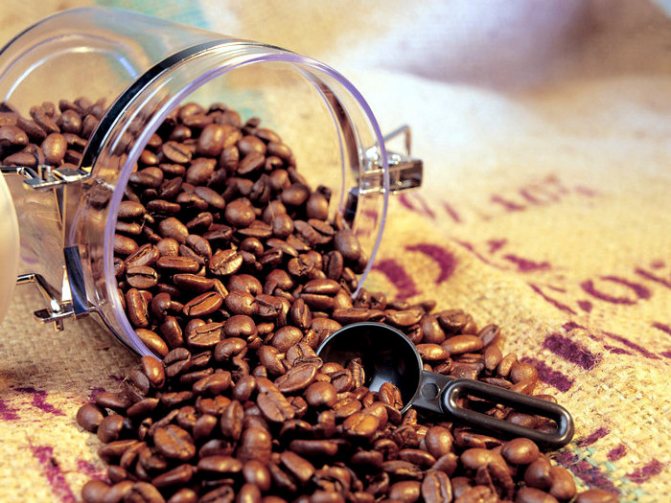
Shelf life and contents of instant coffee drink after opening the vacuum packaging
Instant coffee has a longer shelf life than natural coffee. Cooking technology using artificial additives makes it less organic, and therefore less susceptible to external factors. But even such a drink loses its properties over time: the smell becomes sour and the taste becomes musty.
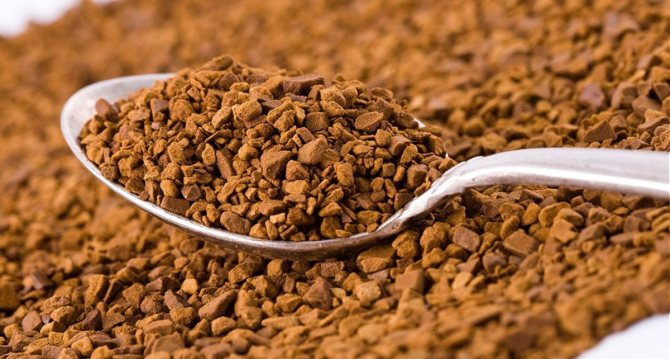
Instant coffee is better preserved in its original packaging or container
If you store an instant drink in an airtight container or original packaging in a dry, dark place, it will remain in its original form for about 2 years. Some manufacturers boast a longer shelf life - up to 3 years.
Unroasted grains
You can of course drink expired coffee. But it’s better not to let it come to that.
It is much easier to purchase green grains. There are several objective reasons for this.
- Much lower price compared to fried. You can compare the rating of bean coffee.
- Can be stored for up to 5 years. Taste and aromatic properties are fully preserved for up to a year.
An important point is packaging. Sealed and vacuum containers ensure a longer shelf life.
If products are purchased by weight, and it is not possible to read the information about the expiration date on the packaging, you need to pay attention to the appearance of the grain. You need to focus on the following rules.
- Fresh grains have the same color and pleasant aroma. The structure is smooth, without chips.
- If the grains have different colors and sizes, then it is probably a mixture of different harvests. As a rule, such a blend will contain old grains, possibly already expired.
- The absence of odor indicates that it is already old grain.
How to properly store coffee at home
Truly delicious coffee can only be prepared from selected high-quality beans. The variety, blending, roasting, and most importantly, proper storage are important here. Compliance with certain conditions is the key to preserving the taste and aroma of this invigorating black drink.
Grains in a glass jar
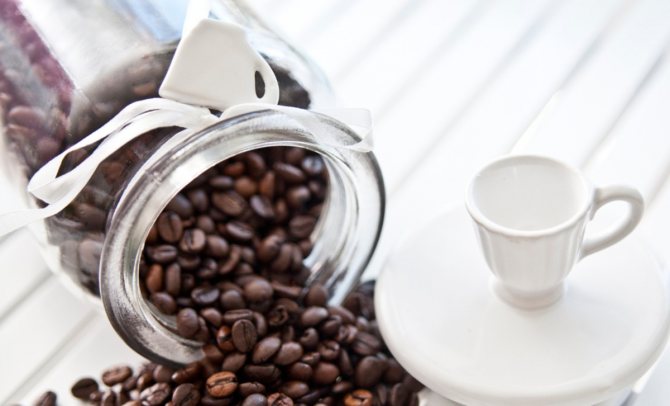
The best place to store coffee beans will be a hanging kitchen cabinet. Ideally, it is completely closed and made of natural material. An important condition is that the shelf with coffee beans should be located at least 4-5 meters from heating devices and at least a meter from the floor. The “neighbors” of the grains will also have to choose calm ones - it is better if they are cereals or pasta. But it’s better to keep the spices away, otherwise the beans will absorb the aromas of the spices.
After opening the package, the grains should be poured into a glass jar with a tight-fitting lid; darkened glass would be best. But after being in a tin or metal can, the coffee will have a metallic taste.
Ground
After grinding, coffee becomes more demanding on storage conditions, so the rules are somewhat specific. Although the general recommendations coincide with the grain version.
If you don’t have a vacuum sealer at home that allows you to extract air from a bag of coffee, then the best option would be to store it in the original pack.
It protects the powder from exposure to light, moisture and foreign odors. In addition, it is created in such a way that condensation does not form inside and the coffee does not become damp. If the opened package does not have a reusable lock, it is necessary to release as much air as possible and tightly twist the edge of the package, securing it with a special clip or a regular stationery clip.
Soluble in tin packaging
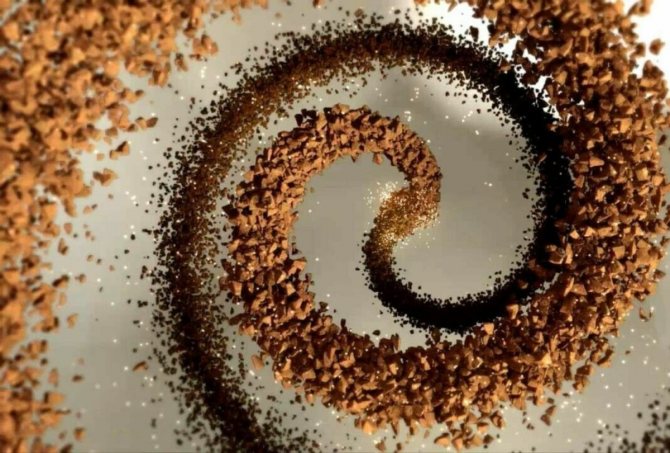
The main enemies of the instant drink are dampness and temperature changes. Because of them, the product will quickly gather in lumps and lose the aromatic substances remaining after processing in production. Dry air and a dark place will preserve the taste characteristics of instant coffee.
If you need to store an open pack for a long time, it is better to wrap it in foil, and in the case of a jar, place a piece of foil between the lid and the container itself. If for some reason the package is opened and the coffee has lost its aroma, you can put a cinnamon stick inside and close the bag tightly, after a few days the coffee will again have the same smell as before.
Basic storage rules
- It is advisable to use the original packaging and store the grains directly in it. If there is an air valve, release the air manually each time.
- If you need to store coffee for a long time, you can purchase foil bags with a zipper. Practical and convenient.
- At home, the best option is to use a jar with a tight-fitting lid. It should be kept in a dry, cool place.
Refrigeration storage is not recommended. The presence of foreign odors can adversely affect the taste of coffee.
What kind of coffee can be stored for a long period
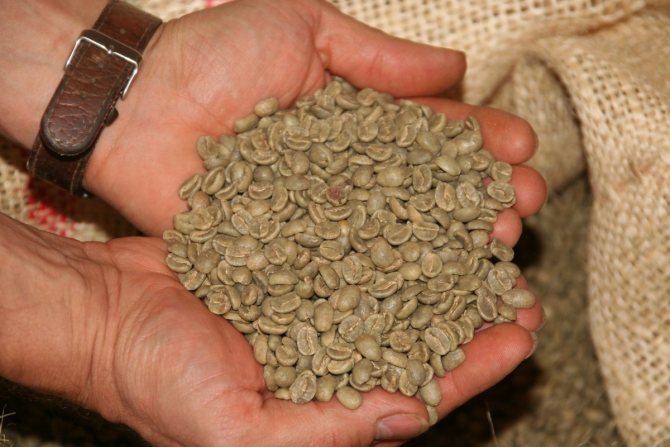
If you plan to store coffee for a long time, and you need to purchase quite a large amount, then raw green beans will be the best option. Their undoubted advantage is their low cost compared to roasted and ground grains. In addition, they are the least demanding on storage conditions, since the aromatic substances are securely contained inside. In this regard, the main requirement is a constant temperature not exceeding 20 degrees. Optimal humidity is also necessary, otherwise the grains will become damp and begin to mold.
An excellent place for storage would be a kitchen cabinet or niche away from heating appliances in bright sunlight.
If the bag of grains is quite voluminous, you should cut its corner without damaging the rest of the package. Having poured the required amount, the cut must be tightly twisted and secured, for example, with a paper clip.
The convenience of buying a large supply of raw coffee beans is that you have a fresh drink at hand at any time: you just need to roast and grind a small handful of beans. At the same time, the coffee will have a deep taste and rich aroma, because the time between heat treatment and brewing of the drink is minimal.
Different types of storage containers
There are several types of packaging in which coffee is usually kept:
- Paper bags;
- Containers made of plastic or metal;
- Foil packaging with check valve;
- Glass or ceramic containers with a tight-fitting lid.
Each type has its pros and cons, which are worth considering in more detail.
Coffee is most often sold in bags made of paper in stores. But this is not the best packaging for the product. It is quite thin and does not protect well from environmental influences. Therefore, after purchasing, when you come home, it is advisable to pour the coffee into another, more suitable container for storage.
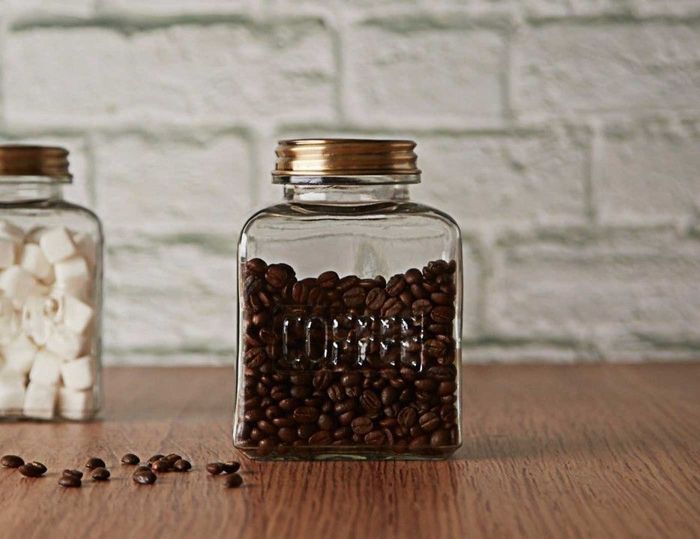
Metal and plastic containers are separated into a single group, since both are poorly suited for storing coffee in them for a long time. The reason for this is that these materials tend to give the product an unpleasant aftertaste, and can themselves become saturated with its odor, which is difficult to remove.
You might be wondering how many times a day and in what quantities can you drink coffee?
Very often glass or ceramic jars are used for this purpose. It is advisable that the lid be equipped with a silicone seal to ensure the tightness of the package. If the container is transparent, then it is advisable to place it in a dark place to prevent exposure to sunlight. The disadvantage of such containers is that there is no possibility of removing carbon dioxide from it.
Therefore, grains that have been roasted independently can be transferred to a jar only after a day. During this time, gases and excess moisture will come out of them.
The best storage option is foil bags equipped with a special clasp and valve. They significantly increase the shelf life of coffee. The opaque material prevents sunlight from reaching the product, and the non-return valve allows excess gas to escape freely from the packaging.
Recommendations for storing in the refrigerator and freezer
The freezer is one of the possible places to store coffee beans. They can be either raw or fried. Moreover, in the second case, freezing should be “shock” and carried out immediately after heat treatment.
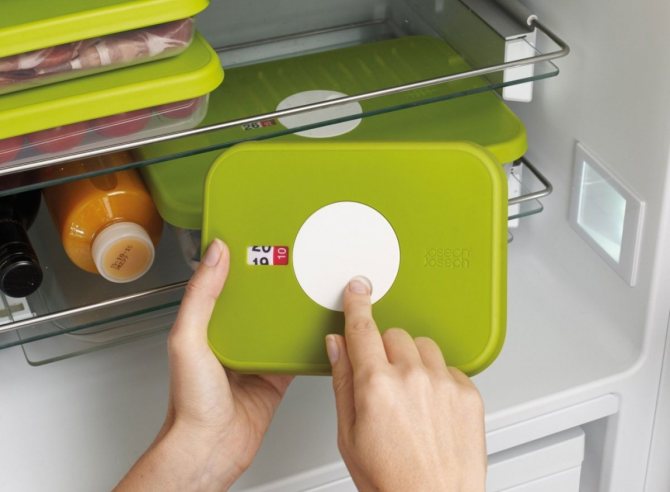
One of the options for long-term storage is the freezer
It is not worth storing a large number of grains in one package at once. In this case, every time you want to drink a cup of coffee, you will have to remove the beans from the cold and keep them warm for a while, then return them back to the freezer shelf. Such temperature changes will turn the grains into a tasteless and odorless product within a couple of months.
It is better to package them in small portions and defrost as needed. It is very important, after the grains are warm, to allow them to thaw on their own: you should not heat them in the microwave or place them near heating appliances. Grinding half-frozen beans is also not a good idea. The optimal temperature for grains ready for further processing and grinding is 15 degrees.
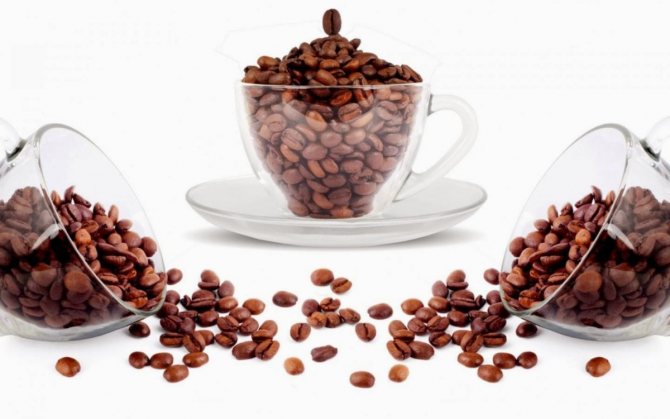
It is better to freeze in small portions; before grinding the grains, you need to defrost them completely.
Even in a frozen state, grains are extremely susceptible to odors, so products with a strong odor, such as fish, meat, seafood, etc., should be kept as far away as possible, otherwise an off-flavor in the finished drink cannot be avoided.
Does coffee have an expiration date?
Like other food products, coffee has a certain shelf life when its taste and aroma qualities are most pronounced. The timing depends on several factors:
- type (grains, ground, instant);
- packaging;
- storage conditions.
The most popular types are grain and ground. For long-term storage, it is recommended to purchase grains: they retain the aroma longer. Roasted ones can be kept for up to 2.5 years without compromising their organoleptic properties. After grinding, it is better to consume it within a couple of weeks, since damage to the integrity of the grains leads to volatilization of essential oils. To delay this process, the container must meet the tightness requirements.
The difference between a good product and a bad one
The main criterion that suggests that coffee has gone bad is the smell. Externally, the grain, ground or instant drink changes little over time. But the aroma, on the contrary, can either disappear completely or become rancid or sour. The difference in taste is also not always noticeable; moreover, drinking an expired drink in most cases is not dangerous, especially if we are talking about raw beans, and it even retains an invigorating effect due to the caffeine content.
Grain
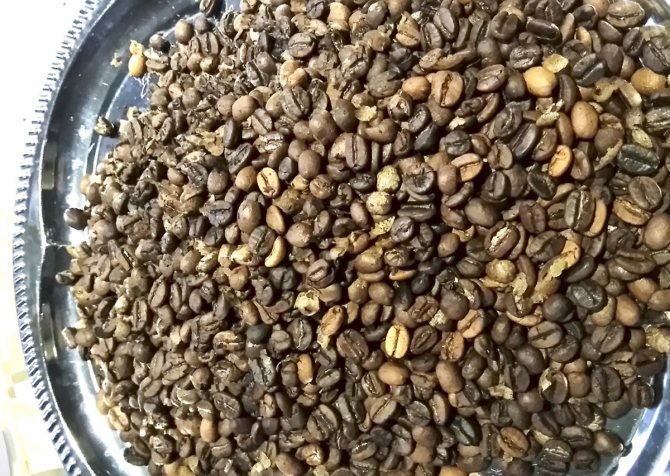
In addition to the obvious damage to the appearance of unroasted beans: mold, sour or musty smell and dried edges, a stale product shows a lack of taste and aroma after roasting. The grains are brittle and empty inside. With high humidity, on the contrary, rotten beans may appear in the bag.
But heat-treated ones, on the contrary, only harden over time and are difficult to grind. They acquire too dark a color due to the oxidation of oily substances, which also give stale grains a rancid smell. In addition, such grains shine unnaturally and stick together.
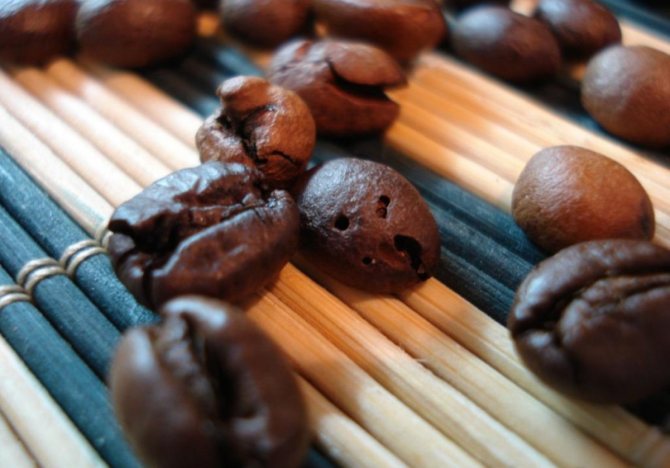
Coffee beans affected by pests
If it’s a pity to part with roasted coffee beans that have lain idle for a long time and have lost their freshness and aroma, you can use them to decorate interior items: photo frames, coasters, flower pots, flower vases, etc. This will give ordinary items an interesting twist, and the grains will not go to waste.
Ground
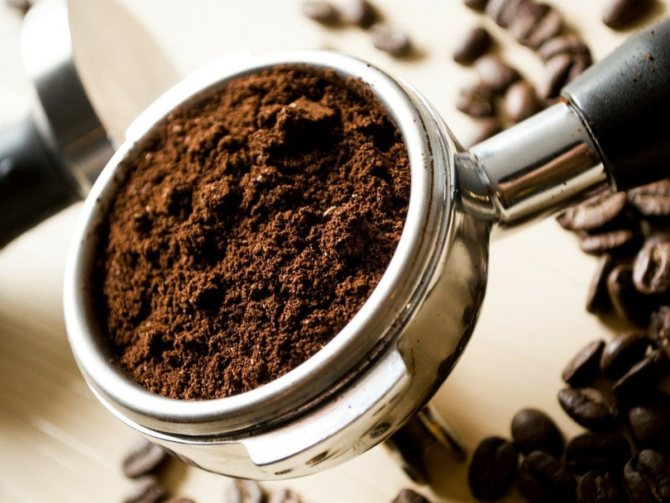
Stale powder will have a non-uniform consistency - lumps in the packaging arise due to long-term storage at high humidity, in addition, the coffee can “melt” and solidify into a single solid mass. It is especially unpleasant if there are any living creatures in the ground drink; this type of coffee is the most suitable for the reproduction of unpleasant creatures.
As for the smell, it is either absent in the stale powder or acquires shades of what the coffee was stored next to.
Soluble
The most resistant type of coffee drink to changes over time. Obvious signs of an expired product are traces of mold and mildew.
Clumping and caking of the granules will also indicate that the shelf life has expired. The smell of stale instant coffee becomes sour or is completely lost. But unpleasant living creatures are found in it extremely rarely, this is due to the peculiarities of production: the low content of essential oils and chemical additives repel parasites.
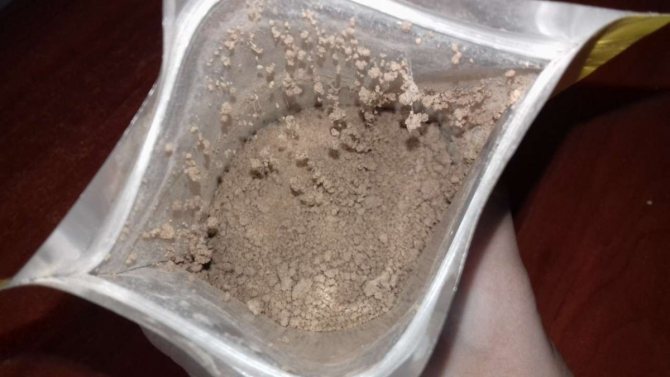
There is mold and cobwebs in the packaging
Currently, there are no cases of poisoning from stale coffee. However, this does not mean that it can be stored carelessly and for a long time. As with any organic product, toxins accumulate and chemical reactions occur. Of course, one cup of such a drink will not do much harm, but systematic use can lead to problems with digestion and liver. In addition, you should not expect pleasant sensations from spoiled coffee: a faded taste with a sour or bitter aftertaste, the absence of a tart aroma and the loss of an invigorating effect are clearly not what coffee lovers expect.
How long can ground grains be stored?
It is worth noting that if you want to buy coffee in reserve, it is better to purchase beans and grind it immediately before use. The thing is that ground grains lose their taste too quickly due to essential oils, which simply evaporate. Even if you purchase such a drink in vacuum packaging, the shelf life after opening it is only 10-14 days.
If we talk about the shelf life of coffee that you grind yourself, then it is three days.
It is best to store ground coffee in a tightly closed container, away from products that have a strong odor. The refrigerator is also not an optimal storage environment, since coffee does not tolerate moisture.
Coffee beans
Many people care about the process of creating an invigorating drink, so they choose grains. They are ground in special coffee grinders, where they emit a unique aroma due to the release of essential oils. Gourmets and coffee lovers prefer this type, as the grain retains a rich taste.
You need to know that unroasted coffee beans are cheaper, and the shelf life of such natural coffee can last up to 3-5 years while maintaining all the taste and beneficial qualities.
In order to understand how to choose fresh coffee beans, you need to keep in mind that:
- Fresh grains have a uniform color and a velvety matte surface.
- A longitudinal groove should be visible and a faint herbal aroma should be felt.
- Fresh grain can be broken in half, and the edges should remain smooth and not crumble.
General storage rules
There should be no drafts in the place where the product is planned to be stored, the temperature is preferably slightly lower than room temperature - 16-17 degrees, humidity - about 60 percent. It would be wrong to put the product in a container and simply place it on a shelf in the kitchen or on a windowsill, where these conditions are not met.
Store coffee correctly by placing it in a sealed, airtight container to prevent excess odors from getting inside.
Earthenware with a rubber gasket and latches on the lid, or a ceramic or glass jar with a screw top are suitable as storage containers. Containers made of metal or plastic are undesirable, as they impart an undesirable taste to the contents.
If the cabinet in which you plan to store the product is located 4-5 meters from the oven, this is a suitable storage location. Some people prefer to keep it on the refrigerator shelf, but opening and closing the door will cause condensation and a lot of foreign aromas will mix with the coffee and ruin it.
Factors that violate the unique taste qualities:
- dampness;
- open air;
- light;
- warm;
- foreign smells.
A little about instant coffee
In this matter everything is much simpler. The shelf life of such coffee is relatively long and equals two years. The reason lies in the fact that during the production of this type, essential oils evaporate and are replaced with artificial additives. In this case, it is worth knowing two things: an opened package of instant coffee is good for 21 days, and if you pour it into a jar with a tight-fitting lid, then 2 months.
How can you store coffee?
There are four different types of packaging for storing coffee, and in order to understand which one to choose, it is worth considering their advantages and disadvantages.
- Paper bag. The cheapest option. Coffee is most often sold in paper bags. But coffee lovers advise pouring coffee from such a container into another, more reliable one. Paper is a very thin material that easily transmits light and moisture, and their grains are not very popular.
- Plastic or metal containers. A common option, but not the most successful. The thing is that the materials from which these containers are made can give coffee a specific taste.
- Foil packaging with a non-return valve. An excellent packaging option, because thanks to this valve you can release air from a pack of coffee, thereby “delaying” the oxidation process, which means it will increase the shelf life of the beans.
- Glass or ceramic jars. One of the most popular methods, because everyone can find such a container in their home. Not a bad choice - the main thing is that the container you choose has a tight lid. For best safety, leave this jar in the cabinet that is furthest from the stove and sink.
Remember! Freshly roasted coffee beans can be placed in another container only after 24 hours. This recommendation does not apply to foil packaging with a valve.


